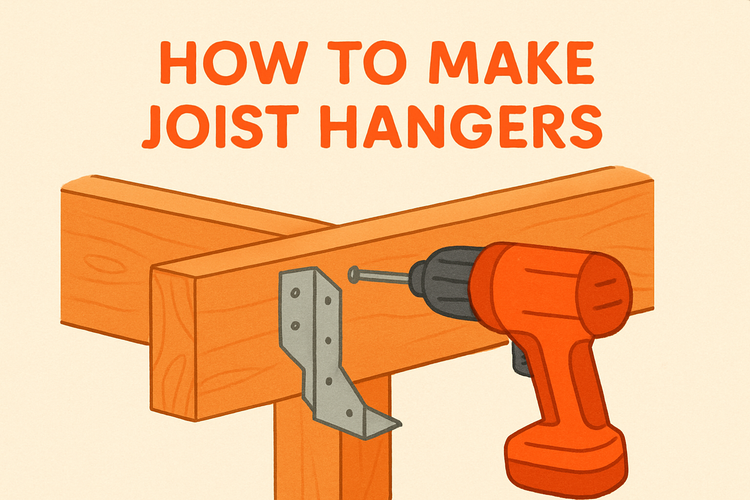How To Make Joist Hangers

Understanding the Basics of Joist Hangers
Before diving into how to make joist hangers, it’s essential to understand what they are and why they matter. These connectors serve as a crucial component in supporting floor and ceiling joists, ensuring loads are properly transferred to beams and walls.
Joist hangers are typically made from heavy-duty galvanized steel and are designed to create a strong connection, preventing movement and sagging over time. These connectors provide long-term stability, especially in structural timber frameworks, and are a staple in both residential and commercial construction. Proper use of joist hangers ensures safety and structural integrity in timber construction projects.
Choosing the right joist hanger depends on the size and type of timber, load-bearing requirements, and environmental conditions such as moisture or exposure to chemicals. Ensuring compatibility with other construction components like post bases or restraint straps can also be critical for overall structural performance.
Materials and Tools Required
To create joist hangers at home or in a workshop, you’ll need a set of sturdy materials and reliable tools. While commercial hangers are made from galvanized steel and pressed with precision, DIY versions can be crafted using sheet metal, tin snips, and a press brake or metal bender.
The most appropriate material for making your own joist hangers is galvanized steel sheet, ideally around 16 to 18 gauge. This type of steel offers a good mix of durability and corrosion resistance. You may also consider stainless steel if working in high-moisture areas where rust is a concern. Essential tools include a grinder or metal scissors, ruler, clamp, hammer, and fastening components such as screws or nails.
Safety is paramount. Always wear gloves and eye protection, especially when cutting and shaping metal. Precise measurements and exact folds are essential for the hanger to maintain structural integrity. Using templates or scale drawings will help streamline the process and avoid common fabrication mistakes.
Designing and Measuring Joist Hangers
Accurate design and measurement are the foundation of a reliable joist hanger. An incorrect width or angle can severely affect performance and safety.
Start by measuring the width and height of the joist that the hanger will support. The hanger must snugly envelope the joist's dimensions without causing frictional damage or leaving gaps. Then calculate how deep the hanger’s legs should extend down the sides of the joist to provide adequate support. Flange tabs can be designed to wrap over the carrying beam or ledger board.
It’s recommended to leave an extra few millimeters in tolerance when cutting the metal to allow for bending and shaping errors. Besides accommodating vertical loads, good design will consider lateral forces as well. Strengthening ribs can be added for increased load capacity, mimicking features found in commercial models like those in joist hanger collections used by professional contractors.
CAD software can be useful for generating precise templates if multiple joist hangers are to be manufactured. This will help you replicate consistent results, especially when working on large-scale timber framing projects.
Cutting, Bending, and Shaping the Metal
Once you have your design, the next step is shaping the steel to match. This involves marking, cutting, and bending the metal sheets into the appropriate hanger shape.
Begin by marking out your template clearly on the steel sheet using a scribe and measuring tape. Cut the edges using tin snips or a metal shear, ensuring clean edges for safety and ease of handling. For clean U-shapes with leg flanges, some corner notching might be required before bending.
Use a press brake or metal bender to fold along your marked lines with precise 90-degree bends. Flanges that rest against the mounting surface need to be bent outward, while the cradle area should be shaped to hold the joist tightly. In areas of repeated use or higher loads, consider using a mallet and steel block to further harden or reinforce bends manually.
To secure the hanger in place, drill pilot holes for nails or screws. Placement should reflect the loading path; most designs follow a triangle configuration to equally distribute the weight. For example, adding multiple fastener points similar to commercial joist hangers enhances stability and provides a safer installation.
Installing DIY Joist Hangers in Timber Frames
Once fabricated, installing your joist hanger is just as critical as its design. Poor installation can compromise even the best-made hanger.
Mark a level line on the supporting ledger or beam at the desired joist height and align your hanger. Use galvanised nails or structural screws to fasten the hanger onto the support. Begin with one flange, check the level again, and then secure the opposite flange. When placing the joist into the hanger, it should sit flush with both the bottom and sides of the hanger cavity.
Avoid overtightening fasteners or misalignment, as it can cause stress in the metal. Check guidelines from professionally made hanger systems, as found under joist hanger products on specialist sites. These offer technical drawings and fastener placement cues that can help mirror high-performance results when working with post base and complementary framing components.
Regular inspection after installation can help identify any loosening or deformities. Especially in high-load areas like decks or garages, ensuring that your hangers remain secure is essential for long-term safety and performance.
